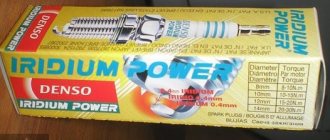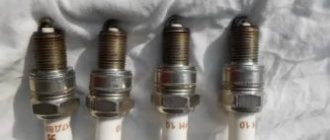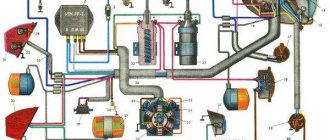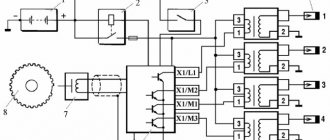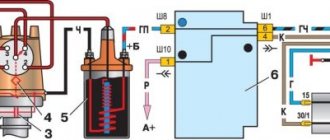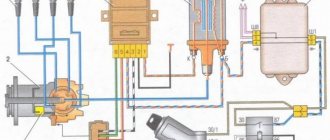Author:
Maxim Markov
Greetings, friends! Tell me, where have you seen an ordinary domestic driver screw in the spark plug correctly, as the installation instructions advise? To be honest, I myself started to worry about this a relatively short time ago. Then, when I learned the possible consequences of poor-quality installation, I immediately changed my approach to this matter! Remember, the tightening torque of the spark plugs plays a key role in the efficiency of the part; its incorrect value can easily destroy not only the spark plug itself, but also the engine! I strongly recommend that you pay attention to such a trifle; believe me, you shouldn’t listen to ignorant drivers who will try to prove the opposite to you! No matter how you feel the key, tightening it by eye is not an option!
Main reasons to follow the recommendations
It turns out that all these drawings on packages of spark plugs are far from comics, and not diagrams for nerds. You can’t ignore them, otherwise don’t be surprised if the part starts to act up! You probably noticed that there is a washer on the threaded part, but have you ever thought about its purpose? According to manufacturers, this metal ring plays a vital role in the process of removing heat from the part. And if the tightening is weak, the candle will not work stably!
And this is just the beginning! More than 90% of breakdowns occur precisely due to improper installation. A low tightening torque leads not only to overheating of the spark plug, but also to loss of compression of the power unit. As a result, vibration appears, which can damage the central electrode or insulator.
However, you should also never overdo it; pharmacy precision is needed here! Otherwise, it is likely that the annular gap between the glow tube and the steel body will narrow, the spark plug will overheat and fail forever, and may even fire. A deformed body and cracked ceramics also indicate that the spark plugs were not installed professionally! And you don’t even have to ask how to calcinate the spark plugs, in this situation it’s pointless!
Correct installation of the spark plug
In one of my previous publications, I already told you everything about replacing spark plugs, but, to be honest, I kept silent about how much force you need to apply when tightening them. I’ll fix this problem right now, armed with just two tools (a regular spark plug and a torque wrench), you can get started.
- Make sure the outside of the spark plug is clean to prevent debris from getting into the engine.
- Check if the sealing washer is in place!
- Place the spark plug vertically and use a spark plug wrench to tighten it to the limit by hand.
- Afterwards, special equipment comes into play, that is, a torque wrench, with its help the tightening torque and angle of rotation are adjusted according to the table, which is located slightly below.
Denso spark plugs are installed in this way; in principle, the same rules must be followed in the case of any similar part, regardless of the brand of manufacture! The only exception concerns the issue of thread lubrication; some companies recommend it; Denso, on the contrary, is opposed to such prevention. The choice is explained simply - the presence of lubricant leads to excessive tightening, and this is extremely undesirable!
When asked what can be used to lubricate the spark plugs before installing them, I answered with graphite lubricant, naturally coated with a thin layer. As you can see, everything is quite simple, the main thing is to have a torque wrench and a table of recommended values. I provided the diagram, all you have to do is get the tool!
Using the spark plug wrench correctly
When installing spark plugs, proper effort is important.
These elements should be tightened all the way without much effort.
When overtightening, you can damage the threads and damage the integrity of the spark plug structure. In this case, heat transfer will be disrupted, and the spark plug may simply fly out under the influence of pressure inside the cylinder block. It is best to carry out the replacement procedure using a torque wrench.
In practice, you can proceed in two stages:
- First, tighten this part by hand until it stops;
- and then tighten it a third of a turn with the key.
The main thing is not to over-tighten.
Advice from manufacturers
Let's return to our "comics", if you have ever bought new spark plugs, you might have paid attention to some quick installation instructions. Different companies have such instructions that look completely different; some manage to sell their products without such hints at all.
Of course, the main information in such factory advice is the exact tightening torque for a specific spark plug. So you need to carefully examine not only the desired part, but also the box from under it. Let's take a quick look at the main brands of the domestic market, how do they approach this issue?
- Bosch - on the set of spark plugs I purchased from this company, there is no useful information at all, although the tightening torque is still indicated in the corner on the individual candle box. As the salesperson of the car dealership explained to me, on other models of the same company they also tell you at what angle to tighten the spark plug, nothing more.
- Denso - here everything is the other way around, an excellent installation diagram is printed on the package, however, such an important value for the tightening torque is missing; you can find it out in the online catalog, which you are recommended to visit.
- NGK - they also indicate the tightening torque and the number of turns, but I still don’t understand clearly how much to do ½ or 2/3 of a turn, there are some inconsistencies. However, the official dealer still recommends ½ turn.
And yet, before purchasing new spark plugs, diagnose the old ones. Find a device for checking spark plugs if you can’t do it with improvised means. It is quite possible that they can be heated and kept in reserve; do not rush to throw them away.
Marking of parts
This parameter is indicated on the bolt head. For parts made on the basis of carbon steel with strength class 2, numbers are indicated through a dot, for example: 3.5, 4.8, etc. The first number indicates 1/100 of the nominal size of the tensile strength, measured in MPa. For example, if the bolt head says 10.1, then the first number means 10*100 = 1000 MPa.
The second figure is the ratio of yield strength to strength, multiplied by 10, according to the above example - 1 * 10 * 10 = 100 MPa.
The yield strength is the maximum load on a bolt. For elements made of stainless steel, steel type A2 or A4 is applied, and then the tensile strength. For example: A4-40. The number in this marking characterizes 1/10 of the tensile strength of carbon steel.
The site editors recommend familiarizing yourself with the SVP and DLS tile leveling systems.
Drewpatch68 › Blog › How hard should I tighten the spark plugs?
The information is not new, however, if, for example, you survey 100 car owners, then only a few will answer the question “with what force to tighten the spark plugs” correctly. Usually, car enthusiasts answer this question with something like “I tighten it by hand,” “I didn’t even think about it,” “I pull it until it stops,” “It doesn’t matter!” and so on.
What is this article for and why did I even take it up? At one seminar, I heard an interesting explanation from an official Bosch representative in Kazakhstan about overheating of spark plugs when they are installed incorrectly in the engine block head. To be honest, before that, I myself had not strictly followed the manufacturers’ instructions, although I had repeatedly seen these recommendations on candle packaging, and like every self-respecting driver, I believed that those small “pictures” on the boxes were indicated either for “nerds” those who love precision, or for those who don’t even have an idea how to screw in spark plugs, or in order not to break the thread in the spark plug well - “well, I’ve been driving for many years and I feel the key!”
The first package of the most standard Bosch spark plugs, which are installed on Nissan, Toyota and other popular brands. On the packaging itself, in which all 10 candles were stored, no information on tightening is given at all. However, on the packaging of each individual candle a wrench is depicted and the tightening torque is indicated - 28 Newton per meter, although on other types of Bosch candles, in addition, a 90-degree turn of the key is also indicated.
Although the tightening torque is not indicated on the packaging of each candle (agree, it wouldn’t hurt to indicate it?), there is an inscription stating that detailed information about installation is indicated in the catalogue, in addition, there is an installation diagram in the form of pictures, where the exact tightening torque values not indicated, but it is indicated that after screwing in the spark plug “by hand”, then you need to tighten it with a wrench 12 turns for a spark plug with a washer-gasket and 116 for a spark plug with a conical seat without a washer - however, please note that there is no inscription anywhere on the packaging that this rule is valid only for new spark plugs, with the washer not yet crushed.
In this very catalog on the applicability of Denso spark plugs there is also a section on installation. I'll try to shed some light on this.
The next point says that you need to screw in the spark plug “by hand”, without using any levers or keys (an extension with a head, in cases where the depth of the spark plug well does not allow this to be done by hand, I think does not count).
This is interesting: How to remove the window lifter handle on Kalina
Finally, in the picture below, I suggest you look at the spark plug washer through which heat is removed. Look at its structure. It's multi-layered. If this washer is not clamped with the required force, the heat dissipation from the internal parts of the spark plug will deteriorate.
In the last article we talked about the correct tightening of spark plugs. Here is this article - How hard should I tighten the spark plugs? Although this installation technology is not new, however, judging by the feedback we received after publication, we confirmed that not many people follow these rules.
From the comments to the article about correct tightening, we have new material for research - the whole point is that one of the discussion participants cast doubt on the fact that the yellow coating around the spark plug is gases escaping through the seals of the metal washer from the combustion chamber. We decided to check it out, and most importantly, show it to you, and we cut exactly the candle that was in the photo in the previous publication.
After loosening the metal washer with a screwdriver, it became clear that the seal was not tight. The color of the ceramic insulator under the washer and in the place where the wire tip was put on is the same. From this experience, we concluded that the ceramics in the washer were indeed not pressed tightly and there was a breakthrough of combustion products to some extent.
Unscrewing instructions
To unscrew, you can use a special hexagon or torque wrench.
Using a torque wrench, the force when unscrewing is controlled, thereby preventing thread breakage. A simple wrench for unscrewing the igniter will not work, as it will not fit into the well, in addition, you may strip the threads or break it.
Each heating element has a hexagon for a torque wrench, which is located approximately in the middle of the spark plug. Thanks to him, twisting is carried out. Usually the insulator breaks off - the upper part of the spark plug. We place the key on the remaining part of the part in the socket. After this, you should slowly begin to unscrew the part with smooth movements. In this case, the collar, head and extension must be held strictly parallel to the axis of the device. The spark plug has a right-hand thread, so it must be unscrewed counterclockwise. The movements must be made without using much force so as not to break the thread, otherwise you will have to go to the service center, since you yourself will no longer be able to unscrew the broken part.
When turning the key, listen to the sounds. If a grinding noise is heard, the part is unscrewed as expected. If you feel a jerk and unscrewing becomes easier, this may mean that the thread has been stripped. In this case, I recommend turning the key back and waiting a little while the thread cools down. Then, using smooth movements in different directions, unscrew the broken part.
Did the candle break?! No problem! The other day, grief overtook me here. On a free day from work, it was decided to do an inspection of my car. I drove it into the garage and began to check all the components and assemblies. It came to the spark plugs, took a spark plug, a guide and a ratchet ( NEVER UNLOCK THE PLUGS WITH A RATCHET
). And on the very first spark plug that I wanted to unscrew, an emergency occurred. The spark plug did not unscrew, I had to apply force, and since I took the tool as a ratchet and the shape looks like a 90-degree angle, when I apply force it turns out that this whole structure moves a little the distortion may not be big, but it’s enough for it to turn out like this.
You hear a crunch, take the head out and see
When you enlarge the picture, you can see that the central electrode is missing and the grounding electrode is visible in the depths.
The rest remained in the head of the engine.
extractor
The first thing to try is to rip the spark plug on a cold engine! (and only when cold). Using an extended head and a long wrench.
Try to make the knob lever as long as possible - this will simplify the process.
Do not make sudden movements, as the candle may simply break - gradually increase the pressure on the shoulder.
Before unscrewing, you can (and should) treat the spark plug with a penetrating lubricant - WD-40.
If this is not available, you can use ordinary kerosene.
It also doesn’t hurt to give a few blows (not too hard) to the extension head or key - tap!
If the spark plug does not unscrew through the incorrect length of the threaded part (since the part of it located in the combustion chamber is covered with soot), then dismantling in the usual way becomes impossible!
Only removing the head will help.
If the spark plug “dead boils,” you will have to not only remove the cylinder head, but also drill it out.
You will get off with a slight scare if the threads in the head remain after drilling.
As a rule, a hole of a larger diameter is drilled, an adapter sleeve is inserted into it, into which a new thread is cut for the spark plug.
What are the dangers of improper tightening?
Indeed, hardly any novice motorists have thought about how to properly tighten the spark plugs. Well, maybe there are only a few who pay attention to such nuances.
Official information from the manufacturer of the best spark plugs in the world (well, maybe one of the best) Bosch: if the tightening torque is incorrect, the most important elements of the car’s ignition system overheat.
It would seem, well, what’s surprising here. America was not discovered. Such information is present on the packaging of SZ, including those produced in Russia. However, only a few people paid attention to the picture with a wrench, under which the recommended tightening torque is written.
It is noteworthy that a certain part of newcomers think so. Like, I’m cleaning the spark plug, I’ve been driving for a long time, I have experience, I feel the key in my hands, I won’t spoil anything. Another part of people who recently got behind the wheel of a car generally consider this additional information unnecessary.
Obviously, all these beliefs are wrong. It's simple - if you don't follow the instructions on the packaging, you can make a lot of mistakes. This also applies to the ineffective operation of the candle. New relatively SZ require replacement after a short period of use; soot and deposits form on them. Ultimately, this all leads to unnecessary costs.
Newbies often wonder why experienced drivers rarely change spark plugs. For some, this becomes a lesson, they become interested and recognize a simple nuance that has always been in front of them.
It turns out that due to incorrect tightening torque, the SZ breaks or overheats. It is clear that with a strong tightening this threatens breakage, with a weak tightening - loss of compression. In addition, insufficient tightening also threatens breakage, since the spark plug vibrates strongly.
Cause of spark plug overheating
The correct way to tighten the spark plug is of great importance because there is heat generation in the well. So, even the gasket provided at the bottom of the thread, where the top of the cylinder and the seat meet, is responsible for normal heat transfer. Otherwise, if you do not follow the tightening torque instructions (for example, if the spark plug is not tightened enough), overheating will occur. The candle itself will operate with low efficiency.
It turns out to be a whole theory. And in fact, this information is not news, but many have simply forgotten about it.
Unfortunately, there are quite a few kits that do not have specific information on this matter. It happens that just a wrench is shown, but the tightening torque is not indicated.
Recommended tightening torque
28 N/m is the spark plug tightening force recommended by the Bosch manufacturer. There are also a number of other rules:
- If the spark plug has a conical seat without a gasket, after screwing it in by hand, you must additionally tighten the element with a 1/16 wrench;
- If the spark plug is ordinary, with a washer, then you need to tighten it an additional 1/2 turn with a wrench.
Note. The above information applies only to new SZ, the installation of which has not yet been completed.
Interesting point. In most cases, retail candles reach the average buyer. They can even be packaged in 4 or 6 pieces, but this is already done on site by dealers, servicemen and salespeople. In fact, candles from most manufacturers come in a package of 10 pieces. But this is considered wholesale.
It is clear that all valuable information remains on the original packaging. It's a rare third-party seller who will copy it on their packaging.
In the table we have given the recommended tightening values for spark plugs with a certain thread diameter. Always follow this information if you do not want the candle to overheat.
Fixation option without torque wrench
The tightening torque for NGK spark plugs is indicated on the box of each product. The principle of screwing “by hand” is also indicated there:
- You need to wrap new spark plugs all the way without any obvious hand force.
- According to the instructions, turn the key to the specified speed in accordance with the engine temperature.
- After this process, the tightness is checked after a few weeks. The candle may weaken.
For classic NGK spark plugs used on most cars, the tightening torque is 20 Nm. But it is better to use standard values. You will need to buy a special torque wrench.
Most car enthusiasts prefer to save money and wrap candles “by eye”. A uniquely shaped key is often sold with candles. If you don't use too much force, you can tighten the hex nut perfectly by hand.
However, there are craftsmen who are accustomed to pulling as far as they can, as long as they have enough strength. And after that, would-be specialists bring the broken candles back to the sellers with a claim that they are defective. And the manufacturer clearly indicates the tightening torque for each product.
How hard should I tighten the spark plugs?
The information is not new, however, if, for example, you survey 100 car owners, then only a few will answer the question “with what force to tighten the spark plugs” correctly. Usually, car enthusiasts answer this question with something like “I tighten it by hand,” “I didn’t even think about it,” “I pull it until it stops,” “It doesn’t matter!” and so on.
What is this article for and why did I even take it up? At one seminar, I heard an interesting explanation from an official Bosch representative in Kazakhstan about overheating of spark plugs when they are installed incorrectly in the engine block head. To be honest, before that, I myself had not strictly followed the manufacturers’ instructions, although I had repeatedly seen these recommendations on candle packaging, and like every self-respecting driver, I believed that those small “pictures” on the boxes were indicated either for “nerds” those who love precision, or for those who don’t even have an idea how to screw in spark plugs, or in order not to break the thread in the spark plug well - “well, I’ve been driving for many years and I feel the key!”
These statements and beliefs are completely wrong. The thing is that if you do not follow the “pictures” on the packages, the candle will not work correctly. This is due to the tight contact in the threaded part and the removal of heat from it, as well as from the washer (gasket), which is placed on the threaded part at the junction of the seat and part of the cylinder head. As all spark plug manufacturers state, the washer also participates in heat transfer and if the plug is not tightened tightly, this will lead to an excessive increase in the temperature of the plug and its unstable operation.
The information is really not new, given that spark plugs were invented a long time ago, but it turns out to be well forgotten. I decided to check whether this information is actually as accessible as the dealer described it, especially since every service station in our city not only has to know this information, but is obliged to know it.
The first package of the most standard Bosch spark plugs, which are installed on Nissan, Toyota and other popular brands. On the packaging itself, in which all 10 candles were stored, no information on tightening is given at all. However, on the packaging of each individual candle a wrench is depicted and the tightening torque is indicated - 28 Newton per meter, although on other types of Bosch candles, in addition, a 90-degree turn of the key is also indicated.
There is no installation information at all on each individual package of Denso spark plugs. Although this is not a stone in Denso's garden. The retail outlet that sells these candles is obliged to warn the client. The chain stretches from the dealer from whom these candles are purchased. Apparently, our sellers are not sufficiently informed, or simply do not want to greatly stretch the process of selling “some kind of candles.”
Although the tightening torque is not indicated on the packaging of each candle (agree, it wouldn’t hurt to indicate it?), there is an inscription stating that detailed information about installation is indicated in the catalogue, in addition, there is an installation diagram in the form of pictures, where the exact tightening torque values not indicated, but it is indicated that after screwing in the spark plug “by hand”, then you need to tighten it with a wrench 12 turns for a spark plug with a washer-gasket and 116 for a spark plug with a conical seat without a washer - however, please note that there is no inscription anywhere on the packaging that this rule is valid only for new spark plugs, with the washer not yet crushed.
Catalogs are the domain of sellers and servicemen - that’s exactly what Denso thinks, judging by the packaging. After all, the information is indicated only on the packaging, where candles of 10 pieces are stored wholesale, and even with a link to this very catalog, which the average motorist consumer has never even seen.
This is interesting: What is the difference between an injector and a carburetor
In this very catalog on the applicability of Denso spark plugs there is also a section on installation. I'll try to shed some light on this.
The first thing Denso recommends doing is to clean the threads of the spark plug well from oil and other contaminants. According to the specialists of this company, it is impossible to lubricate the candle threads at all - this will lead to improper tightening.
The next point says that you need to screw in the spark plug “by hand”, without using any levers or keys (an extension with a head, in cases where the depth of the spark plug well does not allow this to be done by hand, I think does not count).
For NGK spark plugs, the rule for tightening spark plugs is also valid. Only on the packaging of each candle with a washer it is already indicated not only 1/2 of a turn, but also 2/3, besides, the sector on the mug is still 2/3 painted over. Based on this marking, I still don’t clearly understand how exactly I should tighten the spark plug by 1/2 (90 degrees), or by 2/3. For a tapered seat, it gives the same value as the Denso 1/16 turn of the wrench. (If anyone knows why the value of 2/3 is also indicated for a spark plug with a washer, please indicate this in the comments to the article. However, the official dealer says tighten the spark plug by 1/2 turn).
The picture above shows a new spark plug and an old overheated spark plug removed from the engine. Note the darkened ceramic insulator. These are erupted combustion products. In several sources from manufacturers, I found a description of a process in which, as a result of overheating, the seal in a metal nozzle (nut) with a ceramic core insulator was reduced. A normally working spark plug should not have this. Loss of the seal in these places will lead to even stronger heating (after all, it is through the ceramic that the rod transfers heat to the nut and then to the block head). As a result, there could be misfires (unstable operation), and the tip of the spark plug wire could overheat. If the disease is started, then we can get a completely non-functional spark plug, a damaged, cracked, dried out or melted tip, and sometimes engine damage - there have been cases when parts of the spark plug got into the cylinder.
Finally, in the picture below, I suggest you look at the spark plug washer through which heat is removed. Look at its structure. It's multi-layered. If this washer is not clamped with the required force, the heat dissipation from the internal parts of the spark plug will deteriorate.
